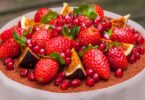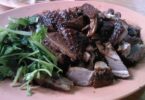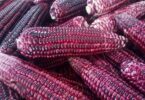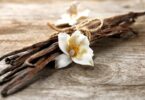Brewing and cooking with traditional teas and tisanes are time-honored and satisfying practices for people all over the world. Teas and tisanes have a long history of being used as ingredients and for producing delicious, comforting flavors in recipes of all kinds, from appetizers to desserts. Take a journey with us to learn more about the various uses for traditional teas and tisanes, as well as what makes them much more than just beverages.
– Exploring the History of Traditional Teas and Tisanes
Types of Tea
Since ancient times, people have enjoyed the calming and invigorating effects of tea. Today, there is a wide variety of both traditional and modern varieties available, ranging from black, oolong, and green teas to herbal tisanes.
- Black Tea – Typically oxidized and full bodied in flavor, black teas are among the most popular types of tea. Popular varieties include English Breakfast and Earl Grey.
- Oolong Tea – Semi-oxidized, oolong teas can contain an array of sweet, aromatic, and earthy notes. Popular varieties include Phoenix Oolong and Iron Goddess of Mercy.
- Green Tea – Unoxidized and generally sweet and vegetal in flavor, green teas offer a variety of health benefits. Popular varieties include Chinese Dragonwell and Japanese sencha.
- Herbal Tisanes – Caffeine-free, herbal tisanes are made from herbs, flowers, and other plant parts. Popular varieties include lavender and chamomile.
Brewing Tea
In order to brew quality tea, it is important to use the correct type of tea leaves and appropriate brewing equipment. Additionally, the water used to prepare the tea should be filtered and free of chlorine and other impurities.
When it comes to brewing traditional tea, it is important to consider the ratio of tea leaves to water, as well as the temperature of the water. Generally, two teaspoons of tea should be used for every eight ounces of water. Depending on the type of tea, the water should be boiled and then allowed to cool to the desired temperature before brewing.
Cooking with Traditional Teas & Tisanes
In addition to being enjoyed as a beverage, traditional teas and tisanes provide an interesting and unique way to add flavor to a variety of dishes.
For example, green tea can be used to make a simple, fragrant tea syrup that is great for drizzling over pancakes, waffles, or French toast. Oolong tea can be used to make a fragrant marinade for pork, while black tea can be used to infuse flavor into dumpling dough.
In addition, many traditional teas and tisanes can be used to make fragrant tea-infused desserts, such as green tea ice cream or black tea creme brulee. Herbal tisanes can also be used to make delicious and refreshing beverages, such as lavender lemonade or chamomile iced tea.
– Understanding the Difference between Traditional Teas and Tisanes
Types of Teas & Tisanes
Traditional tea comes from the evergreen Camellia sinensis shrub, which is native to various parts of eastern and southern Asia. Camellia sinensis is responsible for all true teas, including black, green, oolong, white, and pu-erh, which come in a range of grades, styles, and flavors.
On the other hand, tisanes are not considered traditional teas because they do not come from Camellia sinensis. While the herbal brews can resemble tea and can often take tea-like form, they are made with herbs, spices, fruits, and other plant parts. This means there is an infinite variety of tisanes, commonly including chamomile, burdock root, calendula, hibiscus, and ginger, to name just a few.
How Can Traditional Teas & Tisanes be Used?
Traditional teas and tisanes can be used in a number of ways, from enjoying a simple cup to brewing complex dishes. Here’s a breakdown of just a few of the brewing and cooking options you have when using teas and tisanes:
- As a hot or iced beverage
- In the form of lattes and other coffee alternatives
- In marinades and sauces
- In soups and stews
- In desserts such as cakes, puddings, and ice creams
When used in cooking, traditional teas and tisanes offer a beautiful range of flavors and aromas, perfect for enhancing a dish or plate. Of course, the flavor can vary depending on the tea, spice, or blend being used, so experimenting is key.
Brewing Tips & Tricks
When it comes to brewing the perfect cup of traditional tea or tisane, there are various tips you should keep in mind. For starters, boiling water is too hot for most teas and tisanes, resulting in a bitter, unbalanced brew. Therefore, the key is to use water of the right temperature and infusion time.
Here are some general guidelines to ensure you make the most out of your favorite tea and tisane:
- Green, oolong, and white teas typically require water at approximately 175°F-185° F.
- Black teas and herbal tisanes require water at approximately 200°F-212° F.
- Tisanes generally need to steep for longer than traditional teas, typically 8-10 minutes.
- For traditional teas, use 1 teaspoon (2.5g) of loose-leaf per 8 ounces of water. The strength should be adjusted up or down depending on personal preference.
Overall, traditional teas and tisanes offer a beautiful range of flavors and can be used in a variety of ways. Understanding and respecting the differences between each type is key to developing the perfect cup or dish.
– Investigating Benefits of Traditional Teas and Tisanes
Brewing and cooking with traditional teas and tisanes is something that has been around for centuries and used in many different cultures. Whether you’re looking to kick-start your mornings or relax in the evenings, these herbal-based beverages can do wonders for your health, and the flavours they produce are unbeatable.
The main difference between teas and tisanes is that tisanes, sometimes referred to as herbal teas, are made from floral and herbal ingredients rather than Camellia Sinensis. In other words, tisanes don’t contain caffeine. This makes them the perfect beverage for those who are looking for an alternative to coffee, or those who are caffeine sensitive.
Here are some of the health benefits associated with drinking traditional teas and tisanes:
- Boosts the immune system
- Detoxifies the body
- Promotes digestive health
- Fights infection
- Reduces stress
- Aids in weight loss
- Aids in sleep
- Helps to reduce inflammation
Brewing traditional teas and tisanes is an enjoyable activity and can be enjoyed many different ways. Whether you have a favourite flavour to enjoy or are just looking to try something different, traditional teas and tisanes can be brewed in a variety of ways. Here are some of the staples methods of brewing:
- Infusing - the most popular brewing method that simply requires boiling water and your traditional tea or tisane of choice.
- Steeping – this method is more involved and requires you to place your traditional tea or tisane in a strainer with boiling water and measuring the exact amount of time before drinking.
- Cold-brew – the cold-brew method is perfect for making iced teas and tisanes and requires you to steep your tea or tisane with cold, filtered water for a few hours.
Cooking with traditional teas and tisanes is also becoming increasingly popular as it allows you to create unique flavours in both sweet and savoury dishes. Here are some ways to incorporate these flavours into your cooking:
- Using herbal teas as a simmering sauce
- Infusing your favourite tea into butter to create a spread
- Steeping tea in oil to give your dishes added flavour
- Using tea or tisanes to sandwich ingredients together
- Using them to create marinades or rubs for meats
- Making tea-infused jellies or jams
- Adding tea and tisanes to your favourite baked goods
Traditional teas and tisanes are definitely worth exploring if you’re looking to add an interesting twist to your cooking and brewing. With their health benefits and amazing flavours, there’s a lot to gain from pouring yourself a cup of your favourite traditional tea or tisane.
– Brewing and Cooking with Traditional Teas and Tisanes
Brewing and cooking with traditional teas and tisanes is an art form, and has been around for centuries in many cultures. Traditional teas and tisanes offer many health benefits, while also adding unique flavors and aromas to both food and drinks.
When it comes to brewing and cooking with teas and tisanes, there are a few things you should consider:
- What flavor and aroma are you looking for?
- Which tea or tisane will offer the desired flavor?
- What is the ideal water temperature for the type of tea or tisane chosen?
- How long should the tea steep?
Different teas and tisanes have different flavors, aromas, and health benefits to offer. You may want to experiment with different varieties to find one that suits your tastes best.
Herbal teas & tisanes
Herbal teas and tisanes are often caffeine free and offer many health benefits. They can be brewed as tea, added to recipes for extra flavor, or used as an herbal remedy. Popular herbs for teas and tisanes include chamomile, peppermint, hibiscus, ginger, lemongrass, and many more.
Green tea
Green tea is highly antioxidant and has numerous health benefits. To brew green tea correctly, it should be brewed at a temperature of 175 – 185˚F, and steeped for 2 to 3 minutes. The longer it steeps, the more bitter it will taste.
Black tea
Black tea is a rich, full-bodied tea that is often blended with other flavors to create a unique tasting tea. To brew black tea correctly, it should be brewed at a temperature of 212˚F, and steeped for 3 to 5 minutes. It can be served with or without milk.
Oolong tea
Oolong tea is a semi-fermented tea that has a unique flavor. To brew oolong tea correctly, it should be brewed at a temperature of 185 – 200˚F, and steeped for 3 to 5 minutes. The temperature and steep time can be adjusted for a lighter or stronger brew.
White tea
White tea is made from immature tea leaves and has a delicate flavor and aroma. It should be brewed at a temperature of 175 – 185˚F, and steeped for 2 to 3 minutes. It can be served as a hot tea, or iced for a refreshing beverage.
– Suggested Recipes Made with Traditional Tea and Tisanes
Freshly Brewed Tea
Brewing tea is an art. While it might seem daunting at first, with just a few simple tips, you can easily become an expert. Start by picking out the ideal type of traditional tea for your goal – whether it’s something to enjoy while relaxing or a special beverage for a special occasion. For maximum health benefits, it’s important to stick with the highest quality loose leaf teas. If you’re just getting started, gunpowder green tea is a good beginner’s choice.
Once you’ve chosen your tea, you can begin creating your own unique blend. The trick is to work with complimentary flavors, starting with the top note, the lightest and most dominant flavoring and then adding the middle note for extra complexity, and finally, the base note for a smooth finish. For example, mix peppermint top notes with chamomile middle notes and rose petals at the base for an herbal delight.
Cooking with Tea & Herbs
Cooking with tea and herbs is a great way to elevate the flavor of your meals. From herbal teas in salads to oolongs in soups, these botanicals can add depth and complexity to any dish. For something light, try chamomile tea leaves in a summery green salad. For something more robust, consider brewing your favorite tisane and adding it to your favorite hearty stew.
A lot of tea recipes are as simple as tossing in the tea leaves, but if you want to get creative, you can mix in some herbs and spices. Rosemary and sage make a great pairing with a jasmine tea, while lemongrass and turmeric are great for an oolong base. There are really no bounds when it comes to creating your own signature tea-infused meals.
Experimenting with Tea & Food Pairings
Tastes and preferences vary, so when it comes to tea and food pairing, the possibilities are endless. For instance, a mild green tea pairs well with seafood or light poultry dishes, while a stronger black tea pairs better with creamy and spicy dishes. Earthy herbal tisanes work well with robust flavors such as lamb, beef, or duck. As with any pairing, the aim is to bring out the best of both flavors. You don’t necessarily need to match them perfectly, but the overall effect should be pleasing all around.
When it comes to experimenting with pairings, the key is to have fun with it. Think of each meal as an opportunity to explore new flavor combinations. Mix and match teas and tisanes with your favorite ingredients and find out what works best for you. You may be surprised at the unique flavor profiles you create. Of course, don’t forget to enjoy the process and the delicious final results!
– Creatively Incorporating Traditional Teas and Tisanes in Your Diet
Brewing
- Infuse a range of teas and tisanes: light, refreshing flavourful green teas, rooibos, mild fruit and herb tisanes like hibiscus or chamomile–to create beautiful and unique black teas.
- Brew oolong teas for subtle sweetness, complexity, and smoothness.
- Use shincha, hojicha, bancha–varieties of green tea distinguished by varying amounts of steaming or roasting.
- Brew mate for energizing vitamin-rich natural caffeine.
- Mix and match a variety of teas and tisanes to create custom herbal blends.
Cooking
- Infuse savory broths, stews and sauces with aromatic tea sets for a unique combination of flavors.
- Prepare a sophisticated warm or cold tea soup with mild tea infusion.
- Create tea-infused custards and ice creams, where fragrant tea sets combine with cream and egg yolks to create a smooth texture.
- Mix teas and tisanes with a variety of vegetables to stimulate new flavor profiles.
- Bake light and fluffy cakes and muffins to which you add unique teas like oolong, aged pu-erh or a tisane blend.
– Tips on Storing and Preparing Traditional Teas and Tisanes
Traditional Teas and Tisanes
Although both traditional teas and tisanes are easy to store and quick to brew, there are a few tips to ensure you get the most out of them:
- Keep your teas and tisanes sealed, as exposure to air, heat, and light can make them stale.
- When storing, place the tins or bags in a cool, dark place. Make sure any containers are kept tightly closed.
- Ensure all ingredients like herbs, fruits, and spices remain fresh by purchasing them in small quantities.
- Brew loose leaf teas and tisanes by infusing them in boiling water for two to five minutes, depending on the variety.
- Incorporate teas and tisanes into your cooking for added flavor. They can be used to make teas served hot or cold, sweetened with sugar or honey, or added to dishes to give unique flavor profiles.
When preparing teas and tisanes, remember not to oversteep them. If the flavor is too strong, reduce the steep time. If the flavor isn’t strong enough, steep it longer. Depending on the blend, you may need to adjust the ratios of water and tea leaves. Additionally, use a fine strainer or tea filter to make sure that all the liquid is free from tea leaves or plant debris.
Teas and tisanes can also be infused in hot syrup or added to baking recipes like muffins, scones, and cookies. Experiment with different blends and create your own flavored teas, or enjoy them for their simple, wholesome flavor. Create your own unique blends, or purchase pre-made mixes to take the guesswork out of preparing traditional teas and tisanes. So, the age-old tradition of crafting tantalizing teas and tisanes never grows old. Experience the aromas and the flavors, and learn the art of brewing with the centuries-old wisdom. Welcome to a rich and meaningful traditional tea journey!








